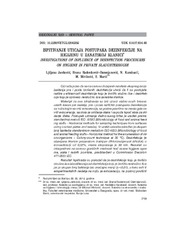Приказ основних података о документу
Investigations of influence of disinfection procedures on hygiene in private slaughterhouse
Ispitivanje uticaja postupaka dezinfekcije na higijenu u zanatskoj klanici
| dc.creator | Janković, Ljiljana | |
| dc.creator | Radenković-Damnjanović, Brana | |
| dc.creator | Karabasil, Nedjeljko | |
| dc.creator | Mirilović, Milorad | |
| dc.creator | Marić, Slobodan | |
| dc.date.accessioned | 2020-06-03T13:31:43Z | |
| dc.date.available | 2020-06-03T13:31:43Z | |
| dc.date.issued | 2012 | |
| dc.identifier.issn | 0350-2457 | |
| dc.identifier.uri | https://vet-erinar.vet.bg.ac.rs/handle/123456789/856 | |
| dc.description.abstract | The objective of this work was to establish, on the grounds of obtained results for the total number of bacteria before and after completed disinfection, whether there are differences in the efficiency of disinfection performed by a professional and disinfection carried out by an unqualified employee in a private slaughterhouse. The material used in these investigations were samples of wet-dry swabs taken over a course of five weeks, before and after disinfection carried out by an unqualified employee and the skilled professional, from the following: the knife used for evisceration, the floor in the evisceration area, from the table serving for bristle removal, and from the floor underneath the bristle removal surface. The wet-dry swabs were taken according to the procedure described in the standard method ISO 18593 (Microbiology of food and animal feeding stuffs - Horizontal methods for sampling techniques from surfaces using contact plates and swabs). Analyzing the taken samples, the total number of bacteria was determined using the standard method ISO 4833 (Microbiology of food and animal feeding stuffs - Horizontal method for the enumeration of microorganisms - Colony-count technique at 30°C). Disinfection was carried out using a chlorine preparation (sodium dichloroisocyanurate dihydrate) in a concentration of 0.02% and for an exposure period of 30 min. The results were interpreted on the grounds of the border values in evaluating the hygiene of the equipment, tools, and work surfaces, presented in Commission Decision 471/2001/ EC. The results of the investogations have shown that the disinfection performed by the skilled professional was more efficient than the disinfection performed by the unqualified person, as the total number of bacteria was significantly smaller (p lt 0.01) in the course of all 5 experimental weeks on the evisceration knife, the floor under the bristle removal surface, during weeks 1, 2 and 5, and on the floor in the evisceration area in weeks 1 and 5. | en |
| dc.description.abstract | Cilj rada je bio da se na osnovu dobijenih rezultata ukupnog broja bakterija pre i posle izvršenih dezinfekcija utvrdi da li su postojale razlike u efikasnosti dezinfekcije koju je izvršilo stučno lice i dezinfekcije koju je sprovelo nestručno lice zanatske klanice. Materijal za ova istraživanja su bili uzorci vlažno-suvih briseva uzetih tokom pet nedelja, pre i posle različitih postupaka dezinfekcije: sa noža kojim se vrši evisceracija, sa podne površine na mestu gde se vrši evisceracija, sa stola za skidanje dlaka i sa poda ispod stola za skidanje dlaka. Postupak uzimanja vlažno-suvog brisa je urađen prema standardnoj metodi ISO 18593 (Microbiology of food and animal feeding stuffs - Horizontal methods for sampling techniques from surfaces using contact plates and swabs). Iz uzetih uzoraka određen je ukupan broj bakterija standardnom metodom ISO 4833 (Microbiology of food and animal feeding stuffs - Horizontal method for the enumeration of microorganisms - Colony-count technique at 30°C). Dezinfekcija je obavljena hlornim preparatom (natrijum dihlorizocijanurat dihidrat) u koncentraciji od 0,02%; vreme ekspozicije je 30 min. Rezultati su interpretirani na osnovu graničnih vrednosti kod ocene higijene opreme, alata i radnih površina, predstavljeni u Commission Decision 471/2001/EC. Rezultati ispitivanja su pokazali da je dezinfekcija koju je izvršilo stručno lice bila efikasnija od dezinfekcije koju je izvršilo nestručno lice jer je ukupan broj bakterija bio značajno manji (p lt 0,01), u toku svih V eksperimentalnih nedelja na nožu za evisceraciju, na podnoj površini ispod stola za skidanje dlaka u I, II i V nedelji, i na podu na mestu gde se vrši evisceracija u I i V nedelji. | sr |
| dc.publisher | Univerzitet u Beogradu - Fakultet veterinarske medicine, Beograd | |
| dc.rights | openAccess | |
| dc.rights.uri | https://creativecommons.org/licenses/by/4.0/ | |
| dc.source | Veterinarski Glasnik | |
| dc.subject | private slaughterhouse | en |
| dc.subject | total number of bacteria | en |
| dc.subject | disinfection | en |
| dc.subject | zanatska klanica | sr |
| dc.subject | ukupan broj bakterija | sr |
| dc.subject | dezinfekcija | sr |
| dc.title | Investigations of influence of disinfection procedures on hygiene in private slaughterhouse | en |
| dc.title | Ispitivanje uticaja postupaka dezinfekcije na higijenu u zanatskoj klanici | sr |
| dc.type | article | |
| dc.rights.license | BY | |
| dcterms.abstract | Марић, Слободан; Раденковић-Дамњановић, Брана; Мириловић, Милорад; Јанковић, Љиљана; Карабасил, Неђељко; Испитивање утицаја поступака дезинфекције на хигијену у занатској кланици; Испитивање утицаја поступака дезинфекције на хигијену у занатској кланици; | |
| dc.citation.volume | 66 | |
| dc.citation.issue | 3-4 | |
| dc.citation.spage | 219 | |
| dc.citation.epage | 231 | |
| dc.citation.other | 66(3-4): 219-231 | |
| dc.citation.rank | M24 | |
| dc.identifier.doi | 10.2298/VETGL1204219J | |
| dc.identifier.fulltext | https://vet-erinar.vet.bg.ac.rs/bitstream/id/1388/855.pdf | |
| dc.type.version | publishedVersion |

